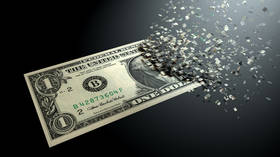Share of dollar in global reserves nosedives – IMF

The US dollar’s share of global central bank reserves has continued to decrease, nosediving to 59.2% in the third quarter of 2023, according to the latest data released by the International Monetary Fund (IMF). The decline comes amid the de-dollarization trend gaining momentum across the globe.
IMF statistics show the greenback’s share is down from roughly 70% in 2000. The dollar remains the world’s leading reserve currency with the euro coming second, while the latter’s share has slid to 19.6%. The Japanese yen’s proportion of world reserves grew to 5.5% from 5.3% in the previous three-month period. The Chinese yuan, British pound, Canadian dollar and Swiss franc were little changed.
Meanwhile, according to data compiled by global financial messaging service SWIFT, the yuan’s share of international payments hit a record high in November, with the renminbi becoming the fourth most used currency worldwide. Cross-border yuan lending has risen as well, while the People’s Bank of China holds over 30 bilateral currency swaps with foreign central banks, including Saudi Arabia and Argentina.
The growing share of the yuan in cross-border transactions reflects China’s trend of shifting away from the dollar, as well as Beijing’s efforts to promote the use of the renminbi, according to SWIFT.
The global trend towards using national currencies in trade instead of the US dollar began to gain momentum last year, after Ukraine-related sanctions saw Russia cut off from the Western financial system and its foreign reserves frozen. The European Bank for Reconstruction and Development (EBRD) has warned that Russia’s growing trade in the Chinese yuan as a response to Western sanctions could potentially erode the strength of the US dollar. Economists have been also indicating that Western trade restrictions have led to an increased usage of the Chinese yuan globally at the expense of the greenback.
For more stories on economy & finance visit RT's business section












